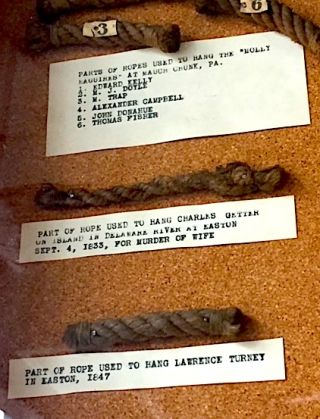Law and Crime
The Dark Lure of Murder Mementos
A fascinating history of criminology appears to be embedded in objects.
Posted September 10, 2023 Reviewed by Abigail Fagan
Key points
- People project an aura onto items associated with the worst kinds of crimes.
- Seeking to see or own “empowered” murder-related items has a long history.
- The allure of murder items that endures reveals truths about our culture.

So much has been reported on the subject of murderabilia that it’s hard to believe there’s more to say. However, crime historian Harold Schechter not only has more to say in Murderabilia: A History of Crime in 100 Objects but he also describes some truly unique collectables. I’m surprised that some of these items still exist. Their enduring value says a lot about us.
Schechter has written many true crime classics about prominent figures like H. H. Holmes and Belle Gunness. In this book, he describes his fascination with the market in murder paraphernalia. He notes that there's nothing new about these collectors; notable crime scenes and murder trials have attracted souvenir hunters and their obliging vendors for centuries. They might cut up a hangman’s noose or even the corpse, using the skin for such things as wallets and belts. They might dismantle whole buildings where a murder occurred, with bloodstained items the ultimate prize. They might cut down a lynching tree and distribute the branches.
The popularity of murderabilia is a manifestation of a latent collective attraction that offers the opportunity to consider values that form our cultural identity. This buying-and-selling enthusiasm for these gruesome items reveals some people's pervasive attraction to violent crime. It expresses their drive to brush up against intense emotion, especially when it feels dangerous. It makes them alert and gives them a rush.
At an inarticulate level, people sense power in acts like torture and murder. In the collectors’ perception, Schechter says, murder-related items possess a vibe like that which true believers claim adhere to religious relics. “If the finger bone of say, St. Sergius, incarnates the mystery of Christian grace, a lock of Charles Manson’s hair embodies the opposite: the mystery of sheer malice, of inscrutable evil.” Schechter himself owns a few pieces, including “the Robert Irwin carved box, one of my treasured possessions, and David Berkowitz’s hymnal.”
Basically, we see in these items what we want to see.
In the true crime arena, you’ll meet all kinds of participants in this morbid marketplace—even victims of crime. There are many levels of collecting, from trading cards to body parts. (I reviewed a novel about the latter here.) I don’t actively collect, but I’ve been gifted with a brick from a chimney at the Lizzie Borden murder house and a piece of a black plastic bag removed from Ted Bundy’s car after his arrest in Utah. I also own items that Dennis “BTK” Rader has made for me about his violent fantasies. And I’m a murder tourist: I visit places where famous murders occurred. I once wrote a travel column about them.
The Internet’s reach has enhanced murderabilia’s visibility and access. One can find a sizeable community of sellers and buyers for items featuring or made by—or just touched by—killers. It could be dirt from a killer’s grave, bullets that killed or wounded someone, crime scene souvenirs, and items a killer offers, like John Wayne Gacy’s rosary, handwritten notes from Ted Bundy, and Glen Rogers’ toenails.
This book is loaded. Schechter offers accounts of about 100 items, dating back to 1808. Included are death masks, engravings, courtroom sketches, pamphlets, movie posters, dime books, and photos from museum exhibits. You’ll see Charles “the Pied Piper” Schmid’s rag-stuffed boots, a bullet-ridden license plate from the car in which Bonnie and Clyde were slaughtered, Nathan Leopold’s incriminating glasses, the shoes from Albert Dyer’s three child victims, Mary Bell’s murder note, Gary Heidnik’s church membership card, and a vial of soil from the Slender Man stabbing site. This is not about some killer's locks of hair or toenails. It’s a fascinating tour of criminological history.
Readers who go through Schechter’s book systematically will experience the sense of a culture enthralled with crime of many varieties. Some incidents happened in other countries, but most entries feature American crimes. Schechter calls his book a “historic tapestry of the most sensational true crimes.” It’s that and more. He doesn’t delve deeply into cultural psychology, but it’s not hard to see that those crime-related items that have held their allure for many years have struck some kind of psycho-cultural chord.
References
Binik, O. (2020). The fascination with violence in contemporary society. Springer.
Denham, J. (2020) Collecting the dead: art, antique and ‘aura’ in personal collections of murderabilia. Mortality, 25:3, 332-347, DOI: 10.1080/13576275.2019.1605985
Schechter, H. (2023). Murderabilia: A history of crime in 100 objects. Workman.


